Exam Details
Exam Code
:E20-555Exam Name
:Isilon Solutions and Design Specialist for Technology ArchitectsCertification
:EMC CertificationsVendor
:EMCTotal Questions
:344 Q&AsLast Updated
:May 29, 2025
EMC EMC Certifications E20-555 Questions & Answers
-
Question 191:
-- Exhibit -A European Sports TV network is considering Isilon for their Media Edit Storage for their editing workloads. They are also considering Isilon for near-line media archiving.
The network receives XDCAM HD footage which is loaded onto their existing Transcoding Storage platform. New footage that needs to be edited will be transferred from their Transcoding Storage platform to the proposed Media Edit Storage
platform at the rate of ten simultaneous XDCAM HD files via FTP. Edited files will be transferred back to the Transcoding Storage platform at the rate of ten simultaneous XDCAM HD files via FTP.
The network currently has 15 Final Cut Pro edit stations, 15 Avid edit stations. Proxy software will be used to allow Isilon to act as the storage for the Final Cut Pro and Avid media. Three of those edit stations will be performing content
compositing as needed.
The network expects 70 hours of new content per week, and 50 hours of edited content per week. They intend to keep the new and edited content on the proposed Media Edit Storage as a performance tier for 30 days. They would like to
retain all new and edited footage proposed Media Edit Storage as a near-line tier for two years.
In addition to the current workloads, the network expects to implement a new Media Asset Management (MAM) solution and has requested the Isilon cluster be capable of supporting 120 MBps read and 120 MBps write to support the MAM
requirements.
-- Exhibit -
Refer to the exhibit.
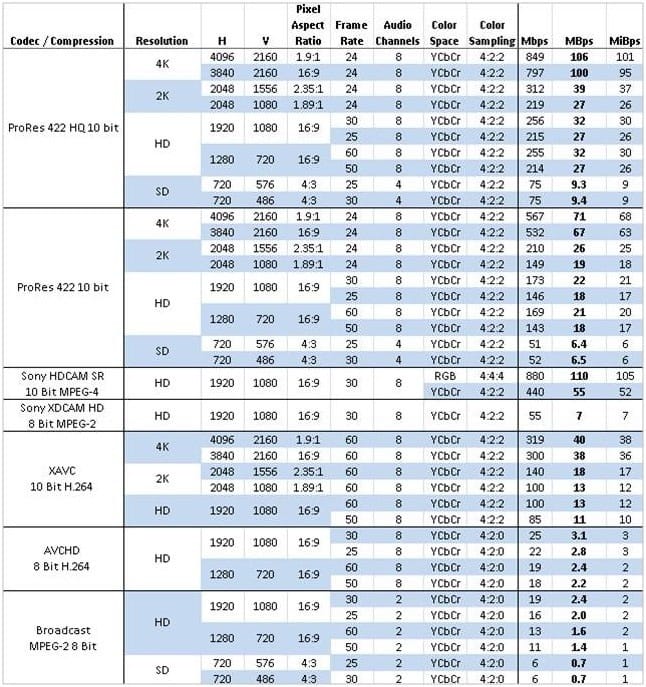
Based on the number of edit stations, and their intended use, what bandwidth requirements should be considered while sizing?
A. Write Performance: 70 MBps FTP sequential 21 MBps NFS and/or SMB sequential 120 MBps NFS and/or SMB random Read Performance: 70 MBps FTP sequential 210 MBps NFS and/or SMB sequential 120 MBps NFS and/or SMB random
B. Write Performance: 550 MBps FTP sequential 275 MBps NFS and/or SMB sequential 120 MBps NFS and/or SMB random Read Performance: 550 MBps FTP sequential
1.6 GBps NFS and/or SMB sequential
120 MBps NFS and/or SMB random
C. Write Performance: 21 MBps FTP sequential 70 MBps NFS and/or SMB sequential 120 MBps NFS and/or SMB random Read Performance: 210 MBps FTP sequential 70 MBps NFS and/or SMB sequential 120 MBps NFS and/or SMB random
D. Write Performance: 70 MBps FTP sequential 210 MBps NFS and/or SMB sequential 120 MBps NFS and/or SMB random Read Performance: 70 MBps FTP sequential 21 MBps NFS and/or SMB sequential 120 MBps NFS and/or SMB random
-
Question 192:
Refer to the exhibit.
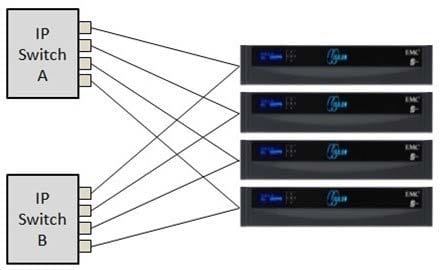
You want to add redundancy to your network configuration, rather than performance. You have configured all interfaces into the default SmartConnect zone. How should you configure the switches and Isilon networking to provide your desired network redundancy?
A. Configure the switch ports for LACP and use LACP aggregation for subnet0:pool0.
B. Configure the switch ports as access points and use LACP aggregation for subnet0:pool0.
C. Configure the switch ports for LACP and use FEC aggregation for subnet0:pool0.
D. Configure the switch ports as access points, bond ext-0 and ext-1 on all nodes and use Active/Passive aggregation for subnet0:pool0.
-
Question 193:
Refer to the exhibit.
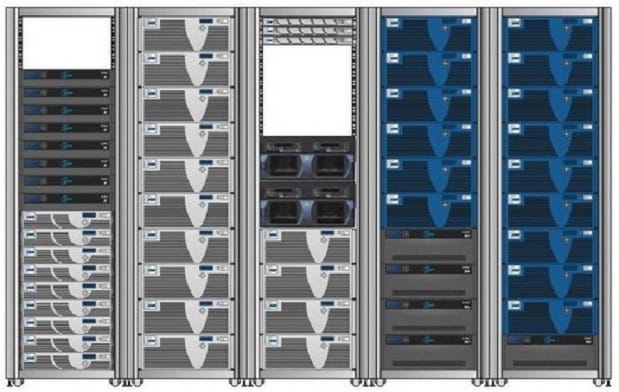
Your customer has three different clusters. File systems on two of the clusters are at 90% full, and the largest cluster is 10% full. Active data resides on the largest cluster. The customer has five different node types totaling 2PB and 54 nodes. Nodes from left to right are as shown: 1.X200 2.12000X 3.36000X 4.NL108 5.108NL
They have a Smartpool license and believe that tiering data would help free up needed space.
After talking with the customer and explaining the use of SmartPools, how would you recommend optimizing utilization across all of the nodes that the customer owns?
A. Attach all nodes to a common Infiniband switch.
B. Go to GUI and put alike nodes in the same pools. Then name them.
C. Borrow nodes to reconfigure the cluster and migrate the data to new cluster.
D. Explain to the customer that this will result in data loss.
-
Question 194:
Refer to the exhibit.

A customer calls you and asks if you could come by and interpret their InsightIQ data. You see that namespace reads are 63% of the work load. What would you recommend to help this cluster's namespace performance?
A. Add SSDs
B. Add A-Series nodes
C. Add S-Series nodes
D. Turn off write cache
-
Question 195:
Refer to the exhibit.

You are analyzing a customer's existing Isilon environment using isi statistics in order to expand the cluster. When examining the protocol subcommand, you see the output as shown in the exhibit. What does the data tell you about the workload?
A. It is metadata intensive.
B. It is mostly sequential reads.
C. It uses large read requests.
D. It contains mostly random writes.
-
Question 196:
Refer to the exhibit.
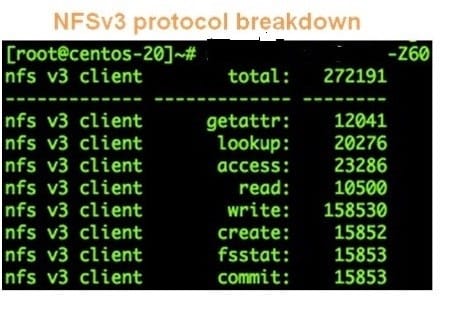
Which tool was used to create this output and which line item counts the metadata read operations occurring in the file service?
A. nfsstat and getattr
B. iostat and fsstat
C. tcpdump and nfsstat
D. isi_netlogger and commit
-
Question 197:
Refer to the exhibit.
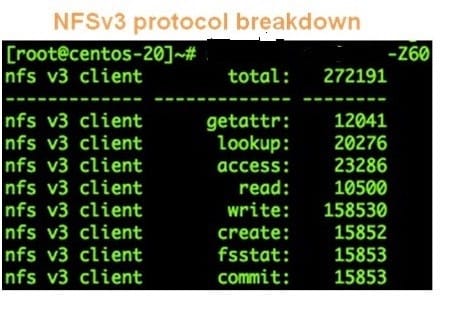
Which tool was used to create this output and what is the most telling characteristic?
A. nfsstat and write-intensive access
B. iostat and write-intensive access
C. Read-intensive access and nfsstat
D. isi_netlogger and moderate metadata read operations
-
Question 198:
Refer to the Exhibit.
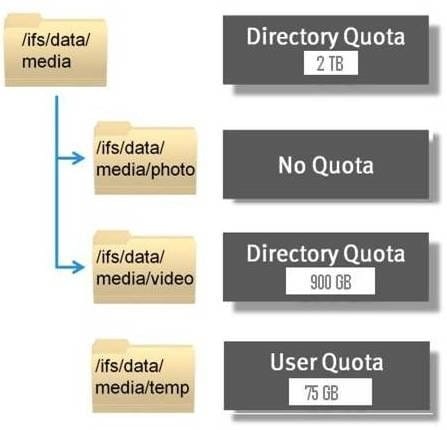
What is represented by the information shown?
A. Directory quota cannot exceed 2 TB for both /ifs/data/media and /ifs/data/media/photo. Directory quota cannot exceed 900 GB for /ifs/data/media/video. Directory quota can be any size up to 2 TB and each user can only store 75 GB for /ifs/data/media/temp.
B. Directory quota cannot exceed 2 TB for /ifs/data/media and no quota limit on /ifs/data/media/photo. Directory quota cannot exceed 900 GB for /ifs/data/media/video. Directory quota can be any size up to 2 TB and each user can only store 75 GB for /ifs/data/media/temp.
C. Directory quota cannot exceed 2 TB for both /ifs/data/media and /ifs/data/media/photo. Directory quota cannot exceed 900 GB for /ifs/data/media/video. Directory quota can be any size up to 2 TB for /ifs/data/media/temp.
D. Directory quota cannot exceed 2 TB for both /ifs/data/media and /ifs/data/media/photo. Directory quota cannot exceed 900 GB for /ifs/data/media/video. Directory quota can be any size up to 900 GB and each user can only store 75 GB for /ifs/data/media/temp.
-
Question 199:
Refer to the exhibit.
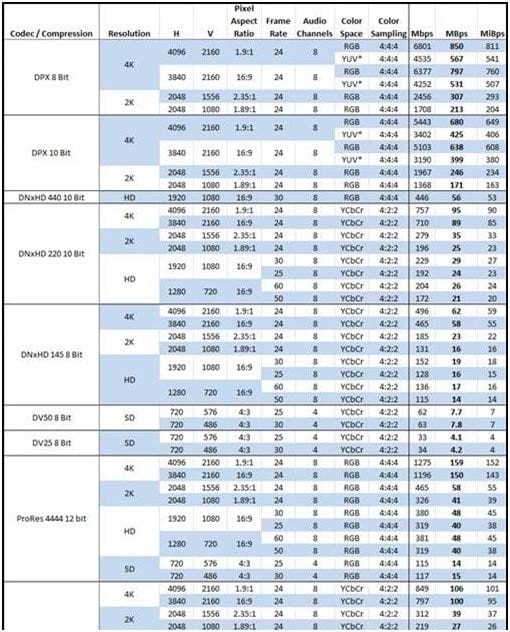
During a requirements gathering meeting, the customer identified a desire to use a codec for editing content that will take up the least amount of space on their Isilon cluster. The content is 1920x1080 HD. Based on the provided list of codecs, which codec would minimize the storage requirement?
A. DNxHD 145 8 Bit
B. DPX 8 Bit
C. ProRes 444 12 Bit
D. DNxHD 220 10 Bit
-
Question 200:
Refer to the exhibit.
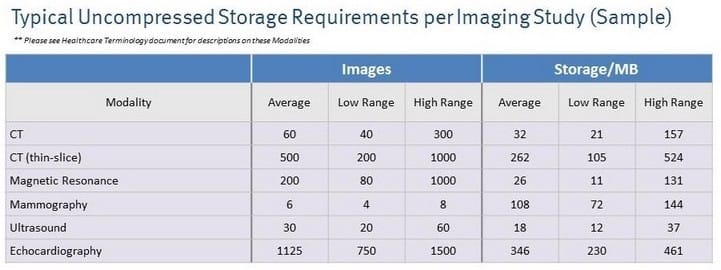
A large hospital chain has approached you to redesign their storage infrastructure. The head of IT believes their requirement is for 60 TB of RAW capacity. The following are the notes from meetings with the department heads. Which is the minimum cluster configuration that meets the customer's requirements?
A. 3 NL-Series Nodes using SynqIQ to 3 NL-Series Nodes
B. 3 S-Series Nodes using SmartPools and 3 NL-Series Nodes for Archive
C. 5 S-Series Nodes
D. 4 X-Series Nodes using SynqIQ to 4 NL-Series Nodes
Related Exams:
D-GAI-F-01
Dell GenAI Foundations AchievementD-MSS-DS-23
Dell Midrange Storage Solutions Design 2023D-OME-OE-A-24
Dell OpenManage Operate AchievementD-PDD-DY-23
Dell PowerProtect DD Deploy 2023D-PE-OE-23
Dell PowerEdge Operate 2023D-PEXE-IN-A-00
Dell PowerEdge XE9680 and XE8640 InstallD-PSC-MN-01
Dell GenAI Foundations AchievementD-PST-MN-A-24
Dell PowerStore Maintenance AchievementD-PWF-DS-23
Dell PowerFlex Design 2023D-RP-DY-A-24
Dell RecoverPoint Deploy Achievement
Tips on How to Prepare for the Exams
Nowadays, the certification exams become more and more important and required by more and more enterprises when applying for a job. But how to prepare for the exam effectively? How to prepare for the exam in a short time with less efforts? How to get a ideal result and how to find the most reliable resources? Here on Vcedump.com, you will find all the answers. Vcedump.com provide not only EMC exam questions, answers and explanations but also complete assistance on your exam preparation and certification application. If you are confused on your E20-555 exam preparations and EMC certification application, do not hesitate to visit our Vcedump.com to find your solutions here.